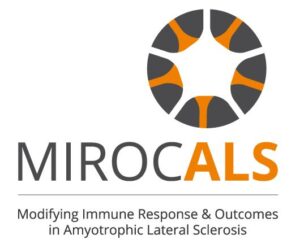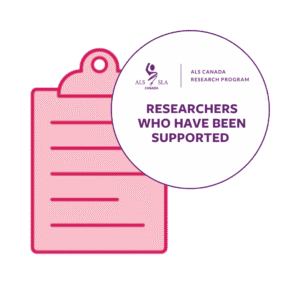 In this project, early-career researcher Farbod Khorrami and Dr. Yeni Yucel’s team (University of Toronto) aimed to identify a novel biomarker* for ALS through ocular imaging. Using mouse models mimicking aspects of ALS, they examined retinal ganglion cells (RGCs), which can be studied non-invasively, unlike motor neurons in the brain. Through eye exams, the team looked for hyperreflective puncta, which are small, bright spots seen in the retina during optical coherence tomography (OCT) imaging. These features are believed to be indicative of inflammation and underlying signs of some diseases. This was the first study to verify that ALS mice had a significantly higher number of puncta in the retinal nerve fiber layer (RNFL) compared to control (healthy) models. An increase in the number of puncta also correlated with age, with female mice showing a greater increase.
In this project, early-career researcher Farbod Khorrami and Dr. Yeni Yucel’s team (University of Toronto) aimed to identify a novel biomarker* for ALS through ocular imaging. Using mouse models mimicking aspects of ALS, they examined retinal ganglion cells (RGCs), which can be studied non-invasively, unlike motor neurons in the brain. Through eye exams, the team looked for hyperreflective puncta, which are small, bright spots seen in the retina during optical coherence tomography (OCT) imaging. These features are believed to be indicative of inflammation and underlying signs of some diseases. This was the first study to verify that ALS mice had a significantly higher number of puncta in the retinal nerve fiber layer (RNFL) compared to control (healthy) models. An increase in the number of puncta also correlated with age, with female mice showing a greater increase.
In addition, the team also looked at axonal spheroids, which are bubble-like features that are formed when a part of a neuron called the axon becomes damaged. These spheroids are commonly found in motor neurons in the brains and spinal cords of people living with ALS. The team also demonstrated the presence of axonal spheroids in the RGC axons of ALS mice, showing promise that the eye could be used to track this damage. Further research is needed to explore these findings, investigate potential sex-differences, and translate these methods to humans. If successful, this project could establish safe, non-invasive, rapid, and relatively inexpensive biomarkers for ALS which could be used to support disease monitoring and track progression. Learn more about some of the researchers behind it here.
* Biomarkers are biological measures that provide real-time insights into processes happening in the body and tell us information about a person’s health status. As an example, the level of cholesterol in the blood can serve as a biomarker for the risk of heart disease. Existing experimental biomarkers for ALS are often expensive, invasive, or not easily accessible by clinicians and patients. Thus, there is an urgent need for accurate and accessible biomarkers within the field to diagnose ALS, track progression of the disease, and measure response to potential therapies in clinical trials.

 Breaking down the breaking news: Researchers at the Sunnybrook Health Sciences Centre are testing a new technology to
Breaking down the breaking news: Researchers at the Sunnybrook Health Sciences Centre are testing a new technology to 
 Breaking down the breaking news: Read about Daniel Knight, an early-career investigator whose lab is funded by the ALS Canada Research program.
Breaking down the breaking news: Read about Daniel Knight, an early-career investigator whose lab is funded by the ALS Canada Research program. In this project,
In this project, 

 In this study, Dr. Lilian Lin (University of Toronto) and the Robertson lab reveal evidence that C9orf72 deficiency worsens ALS-related features in mouse models of the disease.
In this study, Dr. Lilian Lin (University of Toronto) and the Robertson lab reveal evidence that C9orf72 deficiency worsens ALS-related features in mouse models of the disease. Although the ALSFRS-R is considered the gold standard for measuring ALS progression, inconsistencies in descriptions, languages, and the platforms used over time can decrease the reliability of the data, especially in research settings. A recent initiative has led efforts toward further harmonization and training on the scale worldwide. However, difficulties remain, especially for the self-administrated version, which has gained popularity due to its ability to collect data remotely and more frequently than in-clinic assessments. Dr. Allen reviewed multiple studies and highlighted the need for harmonizing a self-administered ALSFRS-R, outlining next steps toward developing a digital, multilingual version that can be used globally.
Although the ALSFRS-R is considered the gold standard for measuring ALS progression, inconsistencies in descriptions, languages, and the platforms used over time can decrease the reliability of the data, especially in research settings. A recent initiative has led efforts toward further harmonization and training on the scale worldwide. However, difficulties remain, especially for the self-administrated version, which has gained popularity due to its ability to collect data remotely and more frequently than in-clinic assessments. Dr. Allen reviewed multiple studies and highlighted the need for harmonizing a self-administered ALSFRS-R, outlining next steps toward developing a digital, multilingual version that can be used globally. In this study, Dr. Daniel Saucier and team in New Brunswick aimed to investigate the association between long-term exposure to various air pollutants and the development of ALS.
In this study, Dr. Daniel Saucier and team in New Brunswick aimed to investigate the association between long-term exposure to various air pollutants and the development of ALS.